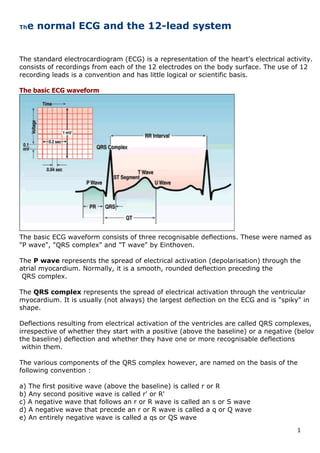The document provides a detailed overview of electrocardiography including:
- The basic components of an ECG waveform and what each component represents in terms of electrical activity in the heart.
- How the 12-lead ECG system works and the placement of electrodes.
- Normal ECG measurements and appearances in both limb and precordial leads.
- How the electrical impulse is conducted through the heart and the normal rhythm.
- A systematic approach for interpreting ECGs including measurements of heart rate, PR interval, QRS duration and corrected QT interval.


![3
obtained from leads L, R and F. These are named as follows:
aVR: RA (+) to [LA & LL] (-)
aVL: LA (+) to [RA & LL] (-)
aVF: LL (+) to [RA & LA] (-)
The precordial/chest leads (horizontal plane)
With each precordial lead, the positive (recording) terminal of the galvanometer is connected to
an electrode at an agreed site on the chest wall, and the negative terminal is connected to an
indifferent electrode, the"V" electrode (see above).
Hence, the chest leads are designated as V1, V2, V3, V4, V5 and V6.
The sites of the above electrodes are as follows:
V1: Right sternal margin at 4th intercostal space (ICS)
V2: Left sternal margin at 4th ICS
V4: Intersection of 5th ICS and left mid-clavicular line
V3: midway between V2 and V4
V5: Intersection of left anterior axillary line with a horizontal line through V4
V6: Intersection of left mid-axillary line with a horizontal line through V4 and V5
Einthoven's triangle hypothesis
Published in 1913, this hypothesis attempts to explain the principles of electrocardiography on a
scientific basis. It is based on four assumptions which are not completely true, but do provide
some basis. The four assumptions are as follows:
1. The trunk is a homogeneous volume conductor.
2. The mean of all the electrical forces generated during the cardiac cycle can be considered as
originating from a dipole situated at the heart’s centre.
3. The limb leads pick up voltage changes in the frontal plane only.
4. The attachments of the three extremities used in making the limb leads (R, L and F) form the
apices of an equilateral triangle with the dipole at its centre.
Determination of the electrical axis
The electrical axis of the heart can be derived from the six frontal plane, and leads to an accuracy
of +/- 15°. The axis is measured by reference to the hexaxial reference system (see figure above).
Calculation of the axis requires determining the algebraic sum of the QRS deflections in each
limb lead. This is done by adding the positive deflections and subtracting the negative
deflections of the QRS complex in any given lead.
Follow these steps for calculating the QRS axis:
1. By inspection, find the frontal-plane lead in which the algebraic sum of the QRS complex
2. deflections most closely approximates to zero (not necessarily the smallest QRS complex!).
The axis will be approximately at right angles to this lead and must therefore lie in
one of two approximate directions.
For example, if the algebraic sum of the QRS complex deflections most closely approximates
zero in lead I, then the axis must lie approximately at either -90° or +90°, which are the two
directions perpendicular to lead I.
3. Now examine the QRS complex in that limb lead which occupies a position at right angles to
4. the original lead (where the algebraic sum of the QRS deflections was close to zero) - i.e. in
lead aVF.](https://image.slidesharecdn.com/thenormalecgandthe12-190804091327/85/The-normal-ecg-and-the-12-3-320.jpg)


















































